Toward Identifying Alternatives to Fencing for Forest Restoration: Tube Shelters Outperform Mesh Shelters for Deer Browse Protection of Live Oak, Quercus virginiana
Abstract
:1. Introduction
2. Materials and Methods
2.1. Experimental Sites
2.2. Experimental Design and Treatments
2.3. Plant Material and Planting Operation
2.4. Measurements
2.5. Statistical Analysis
3. Results
4. Discussion
5. Conclusions
Supplementary Materials
Author Contributions
Funding
Data Availability Statement
Acknowledgments
Conflicts of Interest
References
- Griscom, H.P.; Griscom, B.W.; Ashton, M.S. Forest Regeneration from Pasture in the Dry Tropics of Panama: Effects of Cattle, Exotic Grass, and Forested Riparia. Restor. Ecol. 2009, 17, 117–126. [Google Scholar] [CrossRef]
- Takatsuki, S. Effects of Sika Deer on Vegetation in Japan: A Review. Biol. Conserv. 2009, 142, 1922–1929. [Google Scholar] [CrossRef]
- Cole, R.J.; Litton, C.M.; Koontz, M.J.; Loh, R.K. Vegetation Recovery 16 Years after Feral Pig Removal from a Wet Hawaiian Forest. Biotropica 2012, 44, 463–471. [Google Scholar] [CrossRef]
- Ashton, M.S.; Goodale, U.M.; Bawa, K.S.; Ashton, P.S.; David Neidel, J. Restoring Working Forests in Human Dominated Landscapes of Tropical South Asia: An Introduction. For. Ecol. Manag. 2014, 329, 335–339. [Google Scholar] [CrossRef]
- Suzuki, M.; Ito, E. Combined Effects of Gap Creation and Deer Exclusion on Restoration of Belowground Systems of Secondary Woodlands: A Field Experiment in Warm-Temperate Monsoon Asia. For. Ecol. Manag. 2014, 329, 227–236. [Google Scholar] [CrossRef]
- Leiva, M.J.; Pérez-Romero, J.A.; Mateos-Naranjo, E. The Effect of Simulated Damage by Weevils on Quercus Ilex Subsp. Ballota Acorns Germination, Seedling Growth and Tolerance to Experimentally Induced Drought. For. Ecol. Manag. 2018, 409, 740–748. [Google Scholar] [CrossRef]
- Maltoni, A.; Mariotti, B.; Tani, A.; Martini, S.; Jacobs, D.F.; Tognetti, R. Natural Regeneration of Pinus Pinaster Facilitates Quercus Ilex Survival and Growth under Severe Deer Browsing Pressure. For. Ecol. Manag. 2019, 432, 356–364. [Google Scholar] [CrossRef]
- Russell, F.L.; Zippin, D.B.; Fowler, N.L. Effects of White-Tailed Deer (Odocoileus Virginianus) on Plants, Plant Populations and Communities: A Review. Am. Midl. Nat. 2001, 146, 1–26. [Google Scholar] [CrossRef] [Green Version]
- Beguin, J.; Tremblay, J.P.; Thiffault, N.; Pothier, D.; Côté, S.D. Management of Forest Regeneration in Boreal and Temperate Deer-Forest Systems: Challenges, Guidelines, and Research Gaps. Ecosphere 2016, 7, e01488. [Google Scholar] [CrossRef]
- Burney, O.T.; Jacobs, D.F. Ungulate Herbivory of Boreal and Temperate Forest Regeneration in Relation to Seedling Mineral Nutrition and Secondary Metabolites. New For. 2013, 44, 753–768. [Google Scholar] [CrossRef]
- Burney, O.T.; Jacobs, D.F. Ungulate Herbivory of Regenerating Conifers in Relation to Foliar Nutrition and Terpenoid Production. For. Ecol. Manag. 2011, 262, 1834–1845. [Google Scholar] [CrossRef]
- Woolery, P.O.; Jacobs, D.F. Planting Stock Type and Seasonality of Simulated Browsing Affect Regeneration Establishment of Quercus rubra. Can. J. For. Res. 2014, 44, 732–739. [Google Scholar] [CrossRef]
- Fargione, J.; Haase, D.L.; Burney, O.T.; Kildisheva, O.A.; Edge, G.; Cook-Patton, S.C.; Chapman, T.; Rempel, A.; Hurteau, M.D.; Davis, K.T.; et al. Challenges to the Reforestation Pipeline in the United States. Front. For. Glob. Chang. 2021, 4, 629198. [Google Scholar] [CrossRef]
- Friday, J.B.; Cordell, S.; Giardina, C.P.; Inman-Narahari, F.; Koch, N.; Leary, J.J.K.; Litton, C.M.; Trauernicht, C. Future Directions for Forest Restoration in Hawai’i. New For. 2015, 46, 733–746. [Google Scholar] [CrossRef]
- Löf, M.; Madsen, P.; Metslaid, M.; Witzell, J.; Jacobs, D.F. Restoring Forests: Regeneration and Ecosystem Function for the Future. New For. 2019, 50, 139–151. [Google Scholar] [CrossRef] [Green Version]
- Stange, E.E.; Shea, K.L. Effects of Deer Browsing, Fabric Mats, and Tree Shelters on Quercus rubra Seedlings. Restor. Ecol. 1998, 6, 29–34. [Google Scholar] [CrossRef]
- Löf, M.; Bolte, A.; Jacobs, D.F.; Jensen, A.M. Nurse Trees as a Forest Restoration Tool for Mixed Plantations: Effects on Competing Vegetation and Performance in Target Tree Species. Restor. Ecol. 2014, 22, 758–765. [Google Scholar] [CrossRef]
- Oliet, J.A.; Blasco, R.; Valenzuela, P.; Melero de Blas, M.; Puértolas, J. Should We Use Meshes or Solid Tube Shelters When Planting in Mediterranean Semiarid Environments? New For. 2018, 50, 267–282. [Google Scholar] [CrossRef]
- Redick, C.H.; Jacobs, D.F. Mitigation of Deer Herbivory in Temperate Hardwood Forest Regeneration: A Meta-Analysis of Research Literature. Forests 2020, 11, 1220. [Google Scholar] [CrossRef]
- Redick, C.H.; McKenna, J.R.; Carlson, D.E.; Jenkins, M.A.; Jacobs, D.F. Silviculture at Establishment of Hardwood Plantations Is Relatively Ineffective in the Presence of Deer Browsing. For. Ecol. Manag. 2020, 474, 118339. [Google Scholar] [CrossRef]
- Taylor, T.S.; Loewenstein, E.F.; Chappelka, A.H. Effect of Animal Browse Protection and Fertilizer Application on the Establishment of Planted Nuttall Oak Seedlings. New For. 2006, 32, 133–143. [Google Scholar] [CrossRef]
- Sweeney, B.W.; Czapka, S.J.; Carol, L.; Petrow, A. How Planting Method, Weed Abatement, and Herbivory Affect Afforestation Success. South. J. Appl. For. 2007, 31, 85–92. [Google Scholar] [CrossRef] [Green Version]
- Keeton, W.S. Evaluation of Tree Seedling Mortality and Protective Strategies in Riparian Forest Restoration. North. J. Appl. For. 2008, 25, 117–123. [Google Scholar] [CrossRef] [Green Version]
- Mariotti, B.; Maltoni, A.; Jacobs, D.F.; Tani, A. Tree Shelters Affect Shoot and Root System Growth and Structure in Quercus Robur during Regeneration Establishment. Eur. J. For. Res. 2015, 134, 641–652. [Google Scholar] [CrossRef]
- Oliet, J.A.; Puértolas, J.; Valenzuela, P.; Vázquez de Castro, A. Light Transmissivity of Tree Shelters Interacts with Site Environment and Species Ecophysiology to Determine Outplanting Performance in Mediterranean Climates. Land 2021, 10, 753. [Google Scholar] [CrossRef]
- Tuley, G. The Growth of Young Oak Trees in Shelters. Forestry 1985, 58, 181–195. [Google Scholar] [CrossRef]
- Sharew, H.; Hariston-Strang, A. A Comparison of Seedling Growth and Light Transmission among Tree Shelters. North. J. Appl. For. 2005, 22, 102–110. [Google Scholar] [CrossRef] [Green Version]
- Abe, T. Effects of Treeshelter on Seedling Performance: A Meta-Analysis. J. For. Res. 2021, 27, 171–181. [Google Scholar] [CrossRef]
- Dey, D.C.; Jacobs, D.; McNabb, K.; Miller, G.; Baldwin, V.; Foster, G. Artificial Regeneration of Major Oak (Quercus) Species in the Eastern United States--a Review of the Literature. For. Sci. 2008, 54, 77–106. [Google Scholar] [CrossRef]
- Thyroff, E.C.; Burney, O.T.; Jacobs, D.F. Herbivory and Competing Vegetation Interact as Site Limiting Factors in Maritime Forest Restoration. Forests 2019, 10, 950. [Google Scholar] [CrossRef] [Green Version]
- Salifu, K.F.; Jacobs, D.F.; Birge, Z.K.D. Nursery Nitrogen Loading Improves Field Performance of Bareroot Oak Seedlings Planted on Abandoned Mine Lands. Restor. Ecol. 2009, 17, 339–349. [Google Scholar] [CrossRef]
- Grossnickle, S.C. Why Seedlings Survive: Influence of Plant Attributes. New For. 2012, 43, 711–738. [Google Scholar] [CrossRef]
- Jacobs, D.F.; Salifu, K.F.; Seifert, J.R. Growth and Nutritional Response of Hardwood Seedlings to Controlled-Release Fertilization at Outplanting. For. Ecol. Manag. 2005, 214, 28–39. [Google Scholar] [CrossRef]
- Rose, K.M.; Friday, J.B.; Oliet, J.A.; Jacobs, D.F. Canopy Openness Affects Microclimate and Performance of Underplanted Trees in Restoration of High-Elevation Tropical Pasturelands. Agric. For. Meteorol. 2020, 292–293, 108105. [Google Scholar] [CrossRef]
- Bellis, V.J. Ecology of Maritime Forests of the Southern Atlantic Coast: A Community Profile; National Biological Service; U.S. Department of the Interior: Lakewood, CO, USA, 1995; pp. 1–95.
- Jones, G.; Snider, A.; Luo, S. Changes in the Extent of North Carolina Barrier Island Maritime Forests 1988-2011: An Assessment of Past Efforts at Protection. J. For. 2013, 111, 186–193. [Google Scholar] [CrossRef]
- Mathews, T.D.; Stapor, F.W.; Richter, C.R.; Miglarese, J.V.; McKenzi, M.D.; Barlcay, L.A.; Joseph, E.B. Ecological Characterization of the Sea Island Coastal Region of South Carolina and Georgia. In Volume I: Physical Features of the Characterization Area; Marine Resources Division: Charleston, SC, USA, 1980. [Google Scholar]
- Lopazanski, M.J.; Evans, J.P.; Shaw, R.E. An Assessment of Maritime Forest Resources on the North Carolina Coast; North Carolina Department of Natural Resources and Community Development: Raleigh, NC, USA, 1988; pp. 1–104.
- Abrams, M.D. Where Has All the White Oak Gone? BioScience 2003, 53, 927–939. [Google Scholar] [CrossRef] [Green Version]
- McEwan, R.W.; Dyer, J.M.; Pederson, N. Multiple Interacting Ecosystem Drivers: Toward an Encompassing Hypothesis of Oak Forest Dynamics across Eastern North America. Ecography 2011, 34, 244–256. [Google Scholar] [CrossRef]
- Taggart, J.; Long, Z. Effects of White-Tailed Deer (Odocoileus virginianus) on the Maritime Forest of Bald Head Island, North Carolina. Am. Midl. Nat. 2015, 173, 283–293. [Google Scholar] [CrossRef]
- Thyroff, E.C.; Burney, O.T.; Mickelbart, M.V.; Jacobs, D.F. Unraveling Shade Tolerance and Plasticity of Semi-Evergreen Oaks: Insights From Maritime Forest Live Oak Restoration. Front. Plant Sci. 2019, 10, 1526. [Google Scholar] [CrossRef] [Green Version]
- van Dyke, F.; Wilderman, S.; Harju, S.; Faulkner, J.; Hindy, K.; Kitzel, P.; Marshall, T.; Redick, C.; Rowley, D.; Tolsma, J.; et al. Effects of Soil Treatments and Tree Species on Reforestation of Well Pads. Restor. Ecol. 2022, e13658. [Google Scholar] [CrossRef]
- Earnshaw, K.M.; Baribault, T.W.; Jacobs, D.F. Alternative Field Fertilization Techniques to Promote Restoration of Leguminous Acacia Koa on Contrasting Tropical Sites. For. Ecol. Manag. 2016, 376, 126–134. [Google Scholar] [CrossRef]
- U.S. Climate Data. Available online: https://www.usclimatedata.com/https://www.usclimatedata.com/ (accessed on 26 August 2021).
- Natural Resources Conservation Service, NRCS. United States Soil Survey. Available online: https://www.usclimatedata.com/ (accessed on 26 August 2021).
- Padilla, F.M.; de Dios Miranda, J.; Ortega, R.; Hervás, M.; Sánchez, J.; Pugnaire, F.I. Does Shelter Enhance Early Seedling Survival in Dry Environments? A 4 Test with Eight Mediterranean Species 5 6. Appl. Veg. Sci. 2011, 14, 31–39. [Google Scholar] [CrossRef] [Green Version]
- R Core Team R. R Core Team R: A Language and Environment for Statistical Computing; R Core Team R: Vienna, Austria, 2020. [Google Scholar]
- Bates, D.; Machler, M.; Bolker, B.; Walker, S. Fitting Linear Mixed-Effects Models Using Lme4. J. Stat. Softw. 2015, 67, 1–48. [Google Scholar] [CrossRef]
- Pinheiro, J.; Bates, D.; DebRoy, S.; Karkar, D. R Core Team Nlme: Linear and Nonlinear Mixed Effects Models; R Core Team R: Vienna, Austria, 2018. [Google Scholar]
- Hothorn, T.; Bretz, F.; Westfall, P. Simultaneous Inference in General Parametric Models. Biom. J. 2008, 50, 346–363. [Google Scholar] [CrossRef] [PubMed] [Green Version]
- Ward, J.S.; Gent, M.P.N.; Stephens, G.R. Effects of Planting Stock Quality and Browse Protection-Type on Height Growth of Northern Red Oak and Eastern White Pine. For. Ecol. Manag. 2000, 127, 205–216. [Google Scholar] [CrossRef]
- West, D.H.; Chappelka, A.H.; Tilt, K.M.; Ponder, H.G.; Williams, J.D. Effect of Tree Shelters on Survival, Growth, and Wood Quality of 11 Tree Species Commonly Planted in the Southern United States. J. Arboric. 1999, 25, 69–74. [Google Scholar] [CrossRef]
- Ballaré, C.L.; Pierik, R. The Shade-Avoidance Syndrome: Multiple Signals and Ecological Consequences. Plant Cell Environ. 2017, 40, 2530–2543. [Google Scholar]
- George, J.F.; Powell, J. Deer Browsing and Browse Production of Fertilized American Elm Sprouts. J. Range Manag. 1977, 30, 357. [Google Scholar] [CrossRef] [Green Version]
- Tripler, C.E.; Canham, C.D.; Inouye, R.S.; Schnurr, J.T. Soil Nitrogen Availability, Plant Luxury Consumption, and Herbivory by White-Tailed Deer. Oecologia 2002, 133, 517–524. [Google Scholar] [CrossRef]
- Johansson, T. Changes in Stem Taper for Birch Plants Growing in Tree Shelters. New For. 2004, 27, 13–24. [Google Scholar] [CrossRef]
- Jacobs, D.F. Reforestation of a Salvage-Logged High-Elevation Clearcut: Engelmann Spruce Seedling Response to Tree Shelters after 11 Growing Seasons. West. J. Appl. For. 2011, 26, 53–56. [Google Scholar] [CrossRef] [Green Version]
- van Lerberghe, P. Protecting Trees from Wildlife Damage-Mesh Tree Guards; CNPF-IDF: Paris, France, 2015.
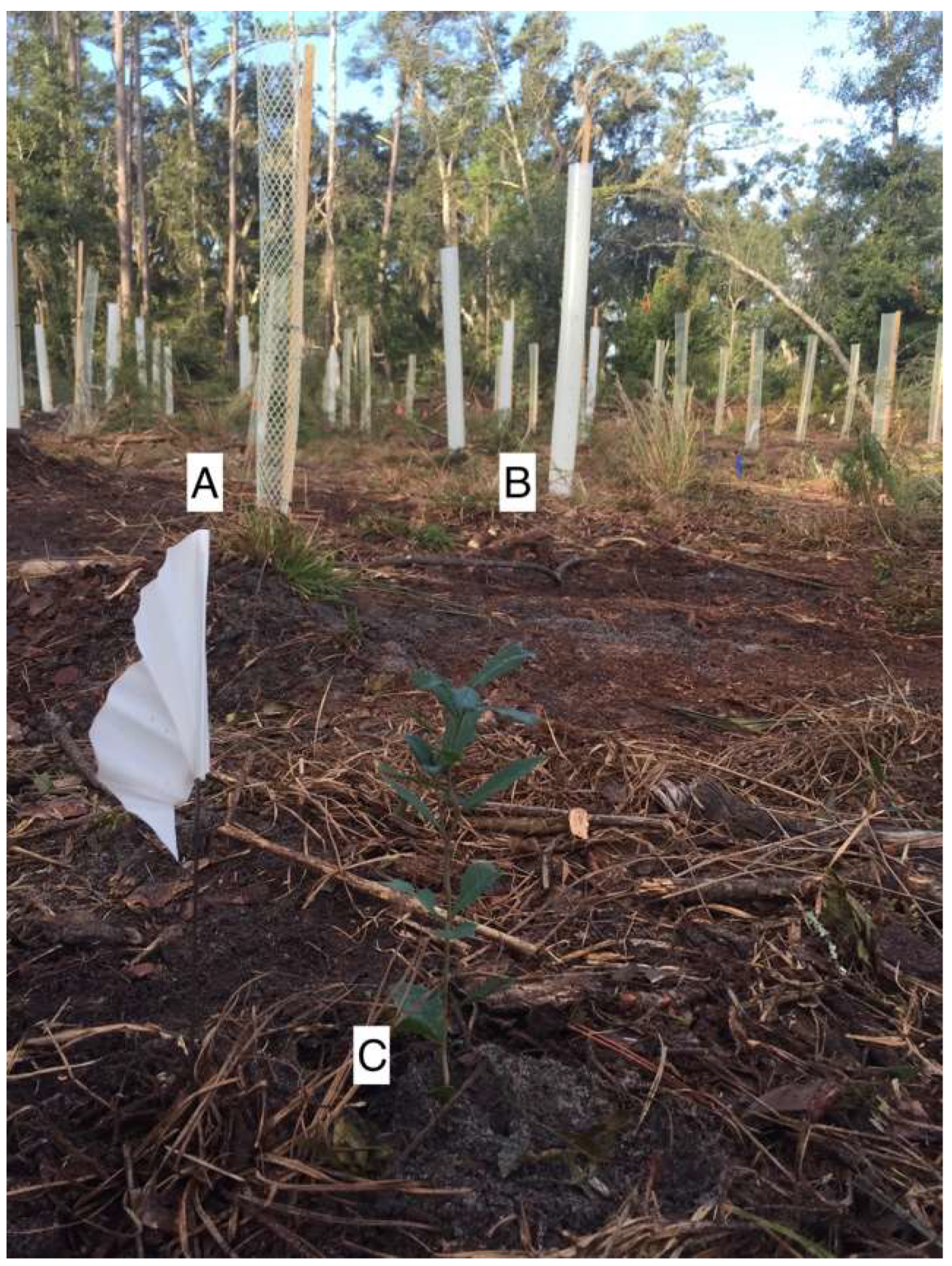
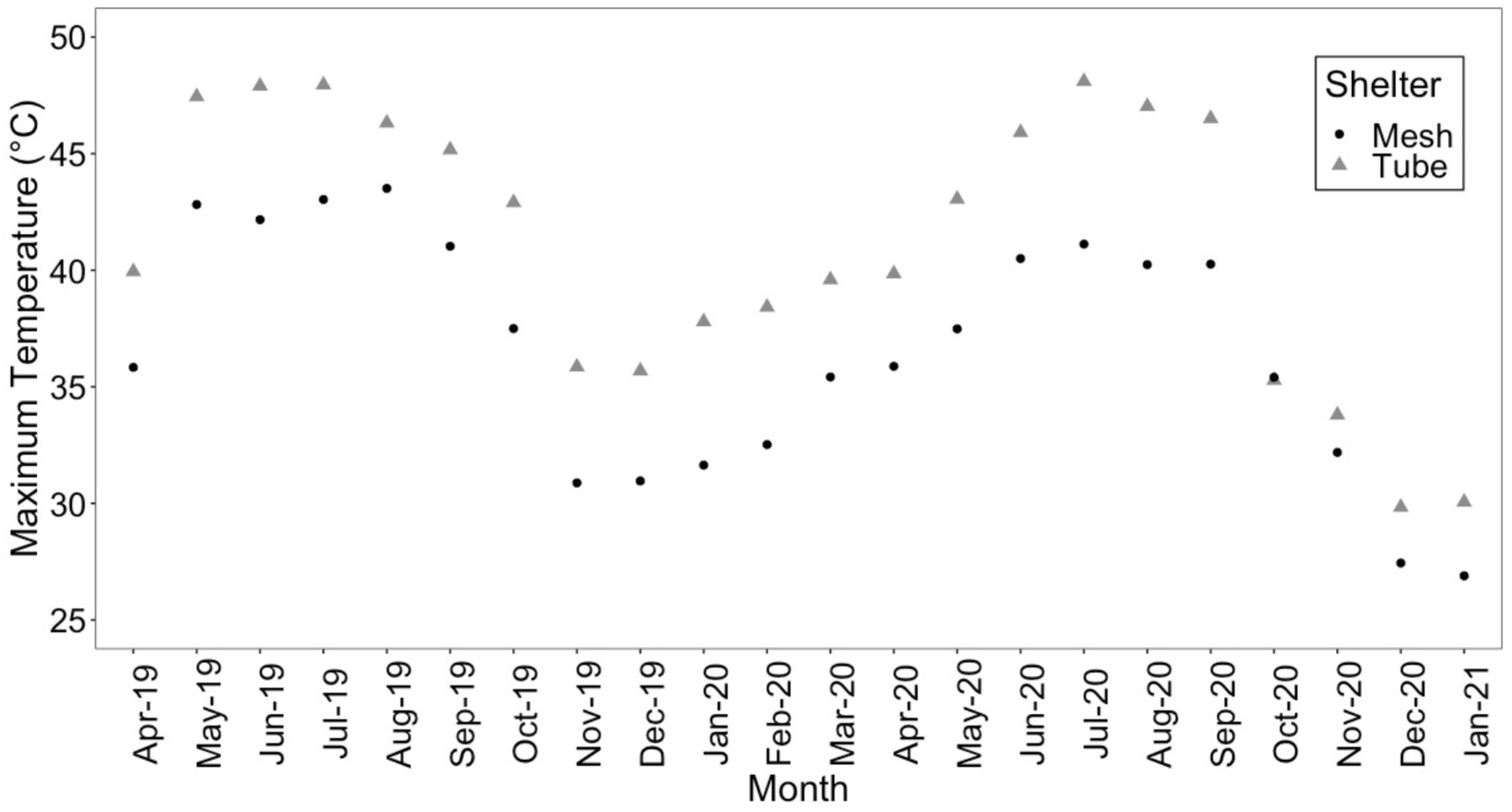
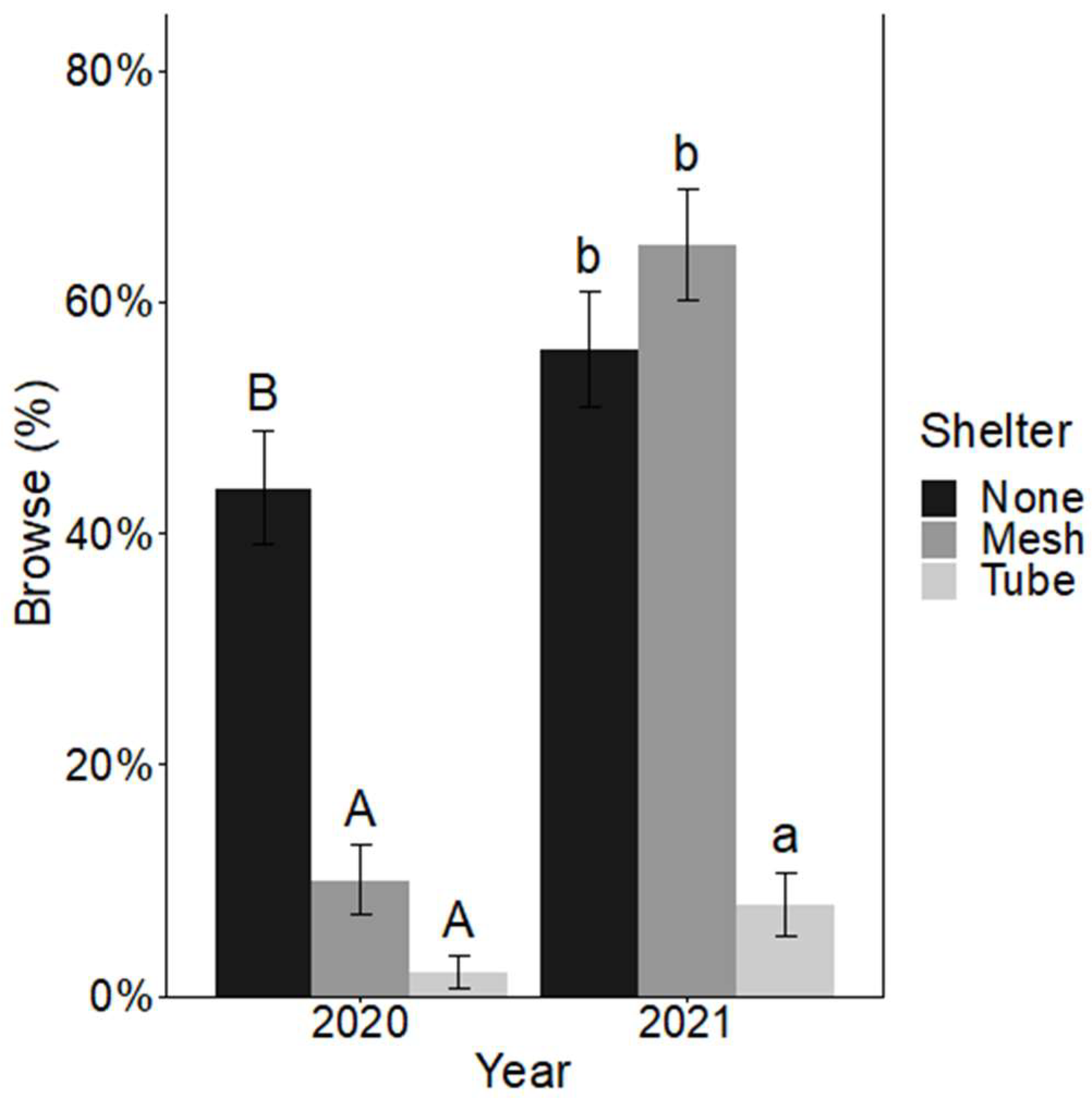

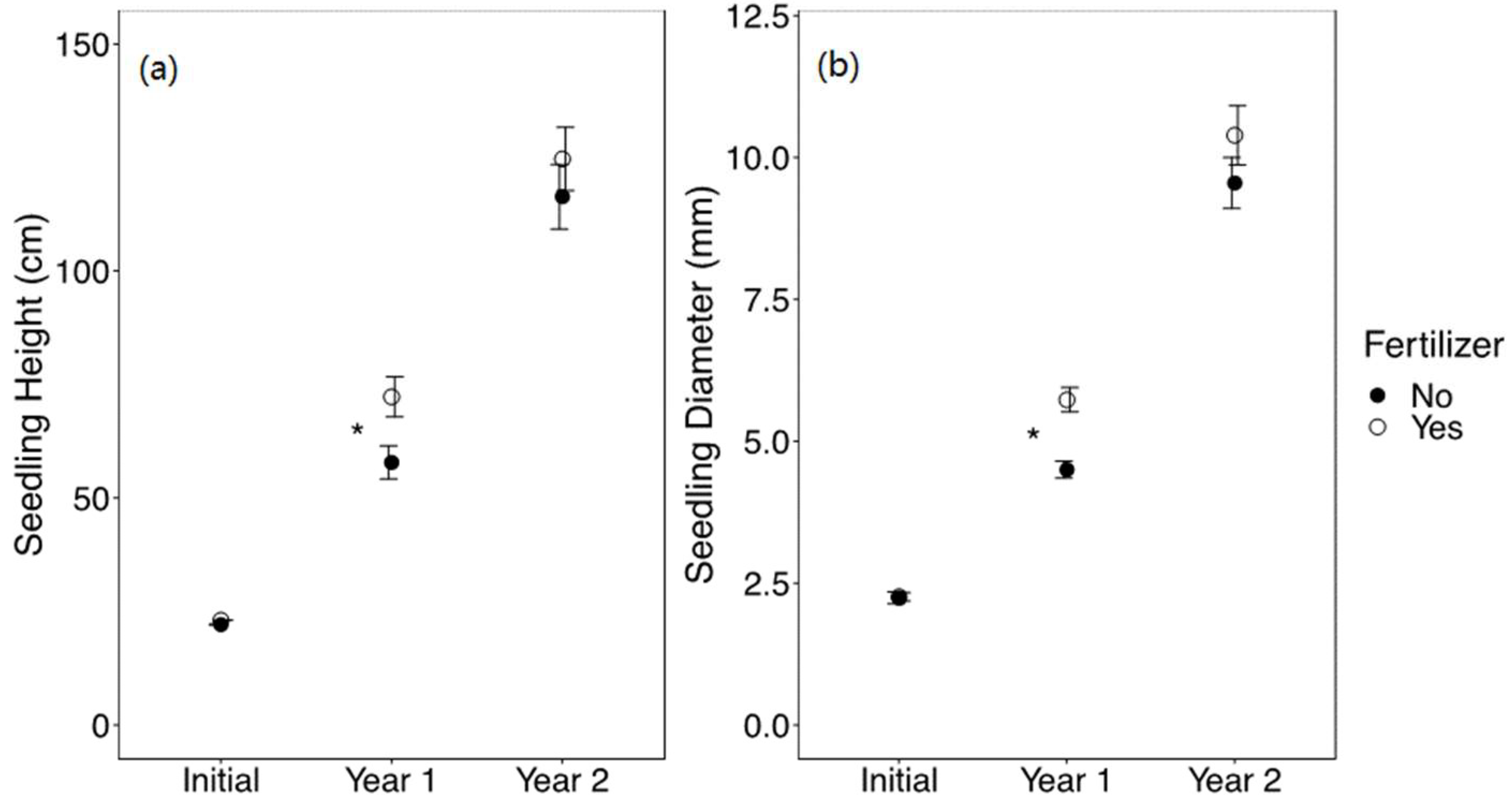
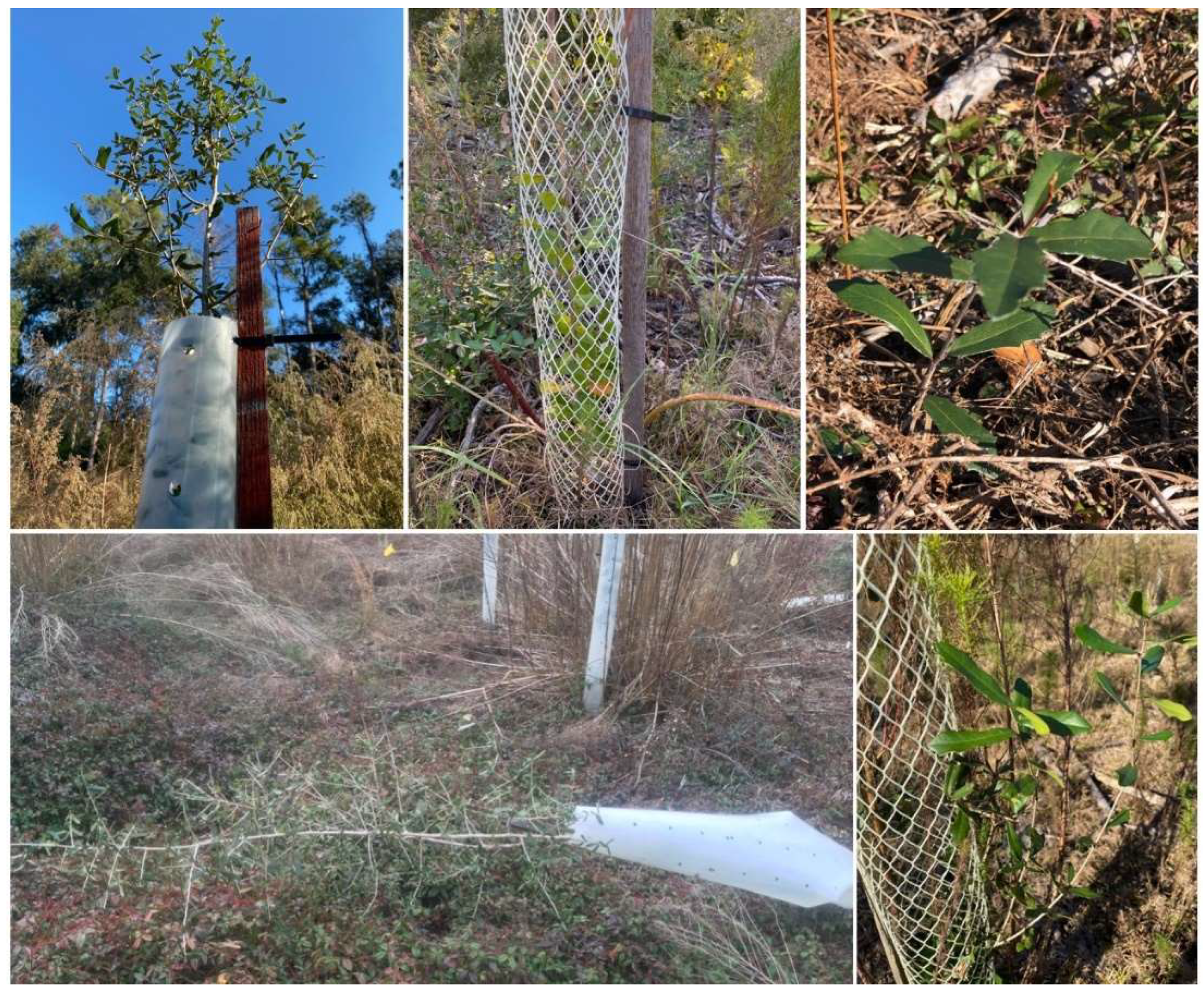
Publisher’s Note: MDPI stays neutral with regard to jurisdictional claims in published maps and institutional affiliations. |
© 2022 by the authors. Licensee MDPI, Basel, Switzerland. This article is an open access article distributed under the terms and conditions of the Creative Commons Attribution (CC BY) license (https://creativecommons.org/licenses/by/4.0/).
Share and Cite
Thyroff, E.C.; Burney, O.T.; Oliet, J.A.; Redick, C.H.; Jacobs, D.F. Toward Identifying Alternatives to Fencing for Forest Restoration: Tube Shelters Outperform Mesh Shelters for Deer Browse Protection of Live Oak, Quercus virginiana. Land 2022, 11, 966. https://doi.org/10.3390/land11070966
Thyroff EC, Burney OT, Oliet JA, Redick CH, Jacobs DF. Toward Identifying Alternatives to Fencing for Forest Restoration: Tube Shelters Outperform Mesh Shelters for Deer Browse Protection of Live Oak, Quercus virginiana. Land. 2022; 11(7):966. https://doi.org/10.3390/land11070966
Chicago/Turabian StyleThyroff, Emily C., Owen T. Burney, Juan A. Oliet, Caleb H. Redick, and Douglass F. Jacobs. 2022. "Toward Identifying Alternatives to Fencing for Forest Restoration: Tube Shelters Outperform Mesh Shelters for Deer Browse Protection of Live Oak, Quercus virginiana" Land 11, no. 7: 966. https://doi.org/10.3390/land11070966
APA StyleThyroff, E. C., Burney, O. T., Oliet, J. A., Redick, C. H., & Jacobs, D. F. (2022). Toward Identifying Alternatives to Fencing for Forest Restoration: Tube Shelters Outperform Mesh Shelters for Deer Browse Protection of Live Oak, Quercus virginiana. Land, 11(7), 966. https://doi.org/10.3390/land11070966






